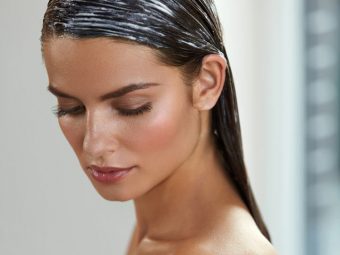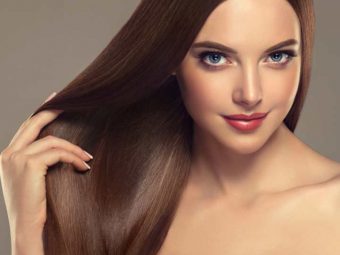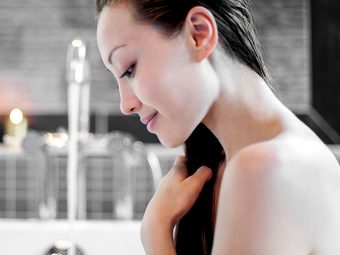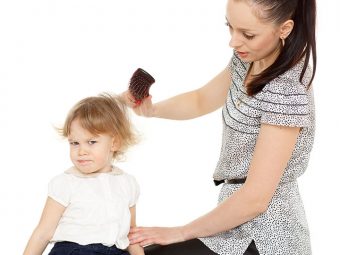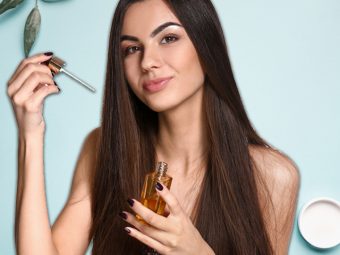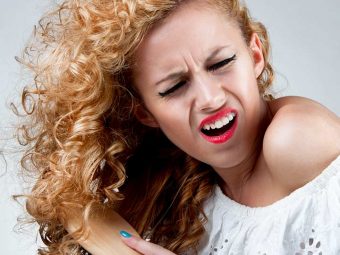Amazing Benefits Of Heat Protectants For Hair & How To Use Them
Protect your tresses from heat and manage your frizz with this essential product!

Image: shutterstock
Hair cannot withstand the excessive heat generated by heat styling products and, in the process, may get damaged. Heat protectants can go a long way in protecting your hair from the damage of blow-dryers, straighteners, and curling irons. They add a layer of protection to your mane, which reduces the negative effects of heat products and boosts hair health. In addition, these protectants keep excessive heat away from your hair.
In this article, we look into the benefits of heat protectants, how to use them to get maximum benefits, and all other related information. Keep scrolling to know more.
In This Article
What Is A Heat Protectant?
A heat protectant adds moisture to your hair and forms a protective barrier. It reduces moisture loss caused by heat applied to your hair shafts. It prevents hair breakage and damage (1). It also minimizes heat damage due to blow-dryers and hair straighteners.
Heat protectants are leave-in products used before styling your hair. They are available in cream, spray, or oil formulas. They can condition your hair, tame frizz, and boost hair shine.
How Does A Heat Protectant Work?
The ingredients in a heat protectant form a thin film on the hair. This film distributes heat evenly and slows down heat conduction.
Heat protectants can benefit your hair in more ways than one. We have briefly discussed them below.
Benefits Of Heat Protectants
- Heat protectants smoothen the cuticles of your hair shaft. They make your hair less porous and less prone to frizz in humid weather (1).
- They restore hair moisture. Using one before styling can keep your hair conditioned (2).
- They prevent moisture loss from factors like dehydration, high heat, or a dry environment. They work by adding a protective layer to your hair shaft.
- They aid hair loss prevention by lubricating your hair and making it more manageable. Your hair will be easy to detangle.
Caroline Amecha, a natural hair and lifestyle blogger, shares her bad experience of heat styling at a Kenyan local salon, “Should I even get started on heat application? Everything was wrong about it. There was no application of heat protectant which is meant to provide a barrier from the heat and reduce chances of heat damage (i).” She reports it as the very first reason that led to the damage to her natural curls.
What Happens If You Skip A Heat Protectant?
Heat from styling tools can dry your hair strands, cause breakage, and make your hair look dull. Your hair comes in direct contact with heat while styling. Skipping a heat protectant means you are allowing the heat from styling tools to strip the color pigments of your hair. The heat can also break down the keratin bonds that otherwise boost hair strength and elasticity. Weak keratin bonds can open your hair cuticles and cause your hair to go dry and frizzy.
Now you know why using a heat protectant is a no-brainer. Its benefits extend beyond protecting your hair from the heat. But here is the thing – using a heat protectant the right way will give you the best results. We have discussed the same below.
How To Use It?
Apply a heat protectant to damp hair before you style. Damp/conditioned hair promotes better absorption of the product. Begin styling once your hair is dry. Use the right tools with ceramic or tourmaline plates that minimize hair damage. If you have dry hair, apply the heat protectant while your hair is wet and top it off with a good conditioning serum before you start styling. Never style your hair while it is wet. Hair is brittle when wet and can break when styled.
Note: You can use heat protectants every time you style your hair. However, minimize using styling tools to reduce hair damage.
Robbie Anne, a fitness and health blogger, writes about how she didn’t take heat protectants seriously at first because of all the ion technology and leave-in conditioning talks around the town. However, she realized her mistakes after her hair started showing signs of damage. “I needed to begin using a daily heat protectant product that could fend off the frizz and lock in the moisture keeping my hair healthy feeling and looking (ii),” she says about how she made changes in her hair care routine to incorporate heat protection.
Heat protectants salvage your hair from the harsh styling tools. However, not all are made alike. The best heat protectants have certain parameters in place. You must look for the same before making a purchase.
 Quick Tip
Quick TipChoose your heat protectant based on the temperature at which you wish to heat-style your hair. Not all heat protectants offer the same level of protection.
What Should You Look For In A Heat Protectant?

Following is the list of ingredients you can check for in your heat protectant.
Silicones: Heat protectants are generally made with a combination of two silicones – Cyclomethicone and dimethicone. While Cyclomethicone moisturizes your hair, dimethicone coats it and prevents moisture loss(3). Dimethicone forms a layer on your hair and makes your cuticles lie flat. This keeps your hair from turning frizzy. You can find this ingredient in your everyday conditioner too. However, those with oily hair must go for a product with minimum silicone (as it can build-up in hair and make hair greasier).
 Quick Tip
Quick TipYou can leave in conditioning oils like coconut, grapeseed, sunflower, almond, or avocado oils as heat protectants once in a while.
Hydrolyzed Wheat Protein: Hydrolyzed wheat protein conditions hair (4). It also takes the place of the natural hair proteins in the hair, which otherwise can get broken due to heat.
PVP/DMAPA Acrylates Copolymer: This copolymer, like silicones, helps protect hair and detangles it. Some research shows this copolymer may protect hair from thermal damage (5).
Quaternary 70: This is found in high-end products that may protect hair from heat damage (5). It keeps hair frizz-free after heat styling. It also keeps your hair smooth until the next wash.
Note: Always consider sulfate- and paraben-free formulas. Go for a color-safe hair protectant if you have color-treated hair. You can also look for propylene glycol and keratin that retain hair moisture and strengthen your hair.
Infographic: Top Advantages Of Using A Heat Protectant
Heat protectants provide several key benefits when it comes to protecting and maintaining the health of your hair. They help maintain the overall strength and integrity of your hair. Incorporating heat protectants into your styling routine is a simple and effective way to keep your hair looking healthy and beautiful. Take a look at the infographic to learn about their top benefits.

Illustration: StyleCraze Design Team
A heat protectant shields your hair from heat damage caused by styling tools. It prevents moisture loss, color fading and hair breakage that are commonly caused due to heat. They coat hair with moisture, forming a protective barrier. Some heat protectants have additional benefits such as curbing frizz, or conditioning hair. It can also prevent the overall damage that styling tools cause such as dryness and decreased hair shine. They smoothen hair, making it more manageable and easier to detangle.You can find heat protectant sprays, gels, and serums easily in salons or beauty stores. Choose the one that suits your hair type and gives good results too. To find a good heat protectant, look for the ingredients mentioned above such as silicones. Now that you know exactly how beneficial heat protectants are, the next time you style your hair, don’t forget to use them!
Frequently Asked Questions
Can I use a heat protectant every day?
Using heat protectant every time you heat-style your hair will prevent hair damage. However, styling your hair with heat daily can make your hair dry, brittle, and prone to breakage. So, it is best to avoid heat styling every day. In addition, it will limit your usage of heat protectant, which ultimately contains chemicals.
Is heat protectant spray or cream better?
Both heat protectant spray and cream have their pros and cons. While the spray is easy to use, applying the cream can be a hassle. However, heat protectant cream is known to provide better protection than the spray.
What should you avoid in a heat protectant?
Heat protectants should be devoid of high alcohol content, synthetic fragrances, and phthalates as they may dry out the hair and cause damage. It should also be free from mineral oil as it may make hair greasy.
Do you put heat protectant before or after the leave-in conditioner?
It is recommended to apply a heat protectant before a leave-in conditioner as it ensures adequate heat protection before styling the hair. After 15 minutes, the conditioner can be applied to impart a shiny look to the hair.
What are some common myths about heat protectants, and how can they be debunked?
There are a few common myths associated with heat protectants. They can be debunked easily with a little research and an understanding of one’s hair type. However, we have covered a few common heat-protectant myths.
Myth: There is no need to apply heat protectant for every hair styling
Truth: Heat protectants should be applied every time while styling the hair with straighteners or blow dryers.
Myth: Heat styling hair can be done regularly if a heat protectant is used.
Truth: Although heat protectants protect hair from heat damage, heat styling of the hair shouldn’t be done regularly as it may negatively affect hair growth and texture.
Myth: All heat protectants are the same
Truth: Every heat protectant has a unique formulation and can vary greatly depending on the hair type
Key Takeaways
- A heat protectant forms a thin barrier around your hair, preventing moisture loss from when you use styling tools like blow dryers or hair straighteners.
- They not only shield hair from heat but also help preserve its natural shine and softness, minimizing damage and breakage.
- It is generally recommended to apply a heat protectant on damp hair before styling to ensure maximum product absorption.
- Always check the ingredients before buying heat protectant sprays and look for sulfate-free and paraben-free formulas.
References
Articles on StyleCraze are backed by verified information from peer-reviewed and academic research papers, reputed organizations, research institutions, and medical associations to ensure accuracy and relevance. Read our editorial policy to learn more.
- The effect of various cosmetic pretreatments on protecting hair from thermal damage by hot flat ironing
https://pubmed.ncbi.nlm.nih.gov/21635854/ - Hair Shaft Damage from Heat and Drying Time of Hair Dryer
https://www.ncbi.nlm.nih.gov/pmc/articles/PMC3229938/ - Hair Cosmetics: An Overview
https://www.ncbi.nlm.nih.gov/pmc/articles/PMC4387693/ - Safety Assessment of Hydrolyzed Wheat Protein and Hydrolyzed Wheat Gluten as Used in Cosmetics
https://pubmed.ncbi.nlm.nih.gov/29761728/ - Thermal degradation of hair. II. Effect of selected polymers and surfactants
https://www.semanticscholar.org/paper/Thermal-degradation-of-hair.-II.-Effect-of-selected-Mcmullen-Jachowicz/93f23e68a31be9a1ddcfd21d5def61c7b0a2418e












